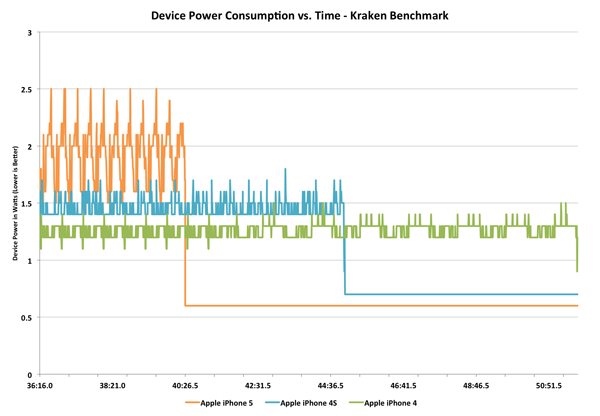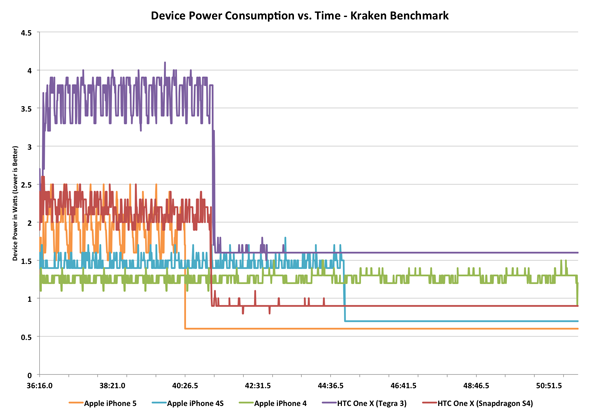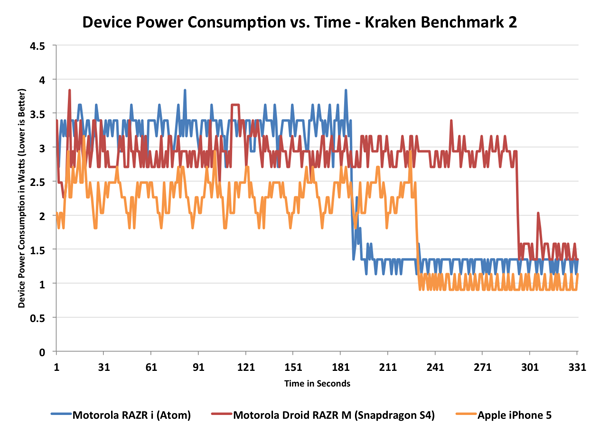The iPhone 5 Review
by Anand Lal Shimpi, Brian Klug & Vivek Gowri on October 16, 2012 11:33 AM EST- Posted in
- Smartphones
- Apple
- Mobile
- iPhone 5
Increased Dynamic Range: Understanding the Power Profile of Modern SoCs
Section by Anand Shimpi
The iPhone 4S greatly complicated the matter of smartphone power consumption. With the A5 SoC Apple introduced a much wider dynamic range of power consumption to the iPhone than we were previously used to. Depending on the workload, the A5 SoC could either use much more power than its predecessor or enjoy decreased overall energy usage. I began our battery life analysis last time with some graphs showing the power savings realized by a more power hungry, faster CPU.
The iPhone 5 doesn't simplify things any more. I believe the days of us having straightforward discussions about better/worse battery life are long gone. We are now firmly in the era of expanded dynamic range when it comes to smartphone power consumption. What do I mean by that? The best way to explain is to look at some data. The graphs below show total device power consumption over time for a handful of devices running the Mozilla Kraken javascript benchmark. Kraken is multithreaded and hits the CPU cores fairly well. The power profile of the benchmark ends up being very similar to loading a very js-heavy web page, although for a longer period of time. All of the device displays were calibrated to 200 nits, although obviously larger displays can consume more power.
Let's start out by just looking at the three most recent iPhone generations:
The timescale for this chart is just how long the iPhone 4 takes to complete the Kraken benchmark. The iPhone 4/4S performance gap feels a lot bigger now going back to the 4 than it did when the 4S launched, but that's how it usually seems to work. Note how tight the swings are between min and max power consumption on the iPhone 4 during the test. As a standalone device you might view the iPhone 4 as being fairly variable when it comes to power consumption but compared to the 4S and 5 it might as well be a straight line.
The 4S complicated things by consuming tangibly more power under load than the 4, but being fast enough to complete tasks in appreciably less time. In the case of this Kraken run, the 4S consumes more power than the 4, however it's able to go to sleep quicker than the 4 and thus draw less power. If we extended the timeline for the iPhone 4 significantly beyond the end of its benchmark run we'd see the 4S eventually come out ahead in battery life as it was able to race to sleep quicker. The reality is that with more performance comes increased device usage - in other words, it's highly unlikely that with a 50% gain in performance users are simply going to continue to use their smartphone the same way as they would a slower device. Usage (and thus workload) doesn't remain constant, it's somewhat related to response time.
The iPhone 5 brings new meaning to device level power consumption. With a larger display and much more powerful CPU, it can easily draw 33% more power than the 4S under load, on average. Note the big swings in power consumption during the test. The A6 SoC appears to be more aggressive in transitioning down to idle states than any previous Apple SoC, which makes sense given how much higher its peak power consumption can be. Looking at total energy consumed however, the iPhone 5 clearly has the ability to be more power efficient on battery. The 5 drops down to iPhone 4 levels of idle power consumption in roughly half the time of the iPhone 4S. Given the same workload that doesn't run indefinitely (or nearly indefinitely), the iPhone 5 will outlast the iPhone 4S on a single charge. Keep the device pegged however and it will die quicker.
Out of curiosity I wanted to toss in a couple of other devices based on NVIDIA and Qualcomm silicon to see how things change. I grabbed both versions of the HTC One X:
The Tegra 3 based One X actually performs very well in this test, but its peak power consumption is significantly worse than everything else. It makes sense given the many ARM Cortex A9 cores built on a 40nm G process running at high clock speeds on the Tegra 3.
The 28nm Snapdragon S4 (dual-core Krait) based One X gives us some very interesting results. Peak power consumption looks identical to the iPhone 5, however Apple is able to go into deeper sleep states than HTC can with its S4 platform. Performance is a little worse here but that could be a combination of SoC and software/browser. I used Chrome for all of the tests so it should be putting Android's best foot forward, but the latest update to Safari in iOS 6 really did boost javascript performance to almost untouchable levels.
At the end of the day, the power profile of the iPhone 5 appears to be very close to that of a modern Snapdragon S4 based Android smartphone. Any battery life gains that Apple sees are strictly as a result of software optimizations that lead to better performance or the ability to push aggressively to lower idle power states (or both). It shouldn't be very surprising that these sound like a lot of the same advantages Apple has when talking about Mac battery life as well. Don't let the CPU cores go to sleep and Apple behaves similarly to other device vendors, but it's really in idle time or periods of lighter usage that Apple is able to make up a lot of ground.
There's one member of the modern mobile SoC market that we haven't looked at thus far: Intel's Medfield. The data below isn't directly comparable to the data above, my measurement methods were a little different but the idea is similar - we're looking at device level power consumption over time while Kraken runs. Here I'm only focusing on the latest and greatest, the Atom based Motorola RAZR i, the Snapdragon S4 based Droid RAZR M and the iPhone 5. The RAZR i/M are nearly identical devices making this the perfect power profile comparison of Atom vs. Snapdragon S4. The RAZR i is also the first Atom Z2460 based part to turbo up to 2.0GHz.
Very interesting. Atom is the only CPU that can complete the Kraken benchmark in less time than Apple's Swift. Peak power consumption is definitely higher than both the Qualcomm and Apple devices, although Intel's philosophy is likely that the added power usage is worth it given the quicker transition to idle. Note that Atom is able to drive to a slightly lower idle level than the Snapdragon S4, although the Swift based iPhone 5 can still go lower.
At least based on this data, it looks like Intel is the closest to offering a real competitor to Apple's own platform from a power efficiency standpoint. We're a couple quarters away from seeing the next generation of mobile SoCs so anything can happen next round, but I can't stress enough that the x86 power myth has been busted at this point.
I will add that despite Intel's performance advantage here, I'm not sure it justifies the additional peak power consumption. The RAZR i ends up being faster than the iPhone 5 but it draws substantially more power in doing so, and the time savings may not necessarily offset that. We'll see what happens when we get to our battery life tests.













276 Comments
View All Comments
mykebrian - Thursday, October 18, 2012 - link
is motorola razr i same price with iphone 5?Death666Angel - Thursday, October 18, 2012 - link
"By controlling its own SoC destiny it could achieve a level of vertical integration that no OEM has enjoyed in recent history."I would argue that Samsung enjoys a similar level of vertical integration. They trade the OS-stuff for some fabs. Not sure which can be more profitable. But other than that, they are very much like Apple in terms of vertical smartphone integration I think. :)
iwod - Thursday, October 18, 2012 - link
Any Reason Why Front Camera not using High Profile When Recording Video? It could have saved yet another bit of space with MUCH better quality then baseline.And do Apple offically support play back of H.264 High Profile Video Clip yet?
Spunjji - Friday, October 19, 2012 - link
I very much appreciated the details on the SoC design. Your attempts to refine your battery life analysis were also appreciated, as these do seem to better reflect real-world usage. In general this article was well-researched, well-written and very informative.Unfortunately, the section on the anodization process does end up reading like one big apology. The matter is explained in detail but it's done with an air of resignation, as if this were the only option available to Apple. The fact is that they could have retained some additional girth (whilst still losing some) and had a device with good handling, good aesthetics and superior durability. No comparison to competing devices is made whatsoever, so we have no idea based on your article alone if this really is unavoidable or just poor choice of materials.
The same goes for the part about the camera flare. Is a short comparison with a few relevant models too much to ask? The problem is that (like the previous criticism) I already know how this comes out and it doesn't look very good for Apple.
So there are hundreds of hours spent testing comparative performance and battery life where Apple win, yet no time at all dedicated to comparative analysis where they do not look so good. That starts to look upsettingly like bias. I hope that isn't the case but based on other areas (notebook reviews in particular) it starts to feel like a theme.
Anandtech, as a site I love your tech journalism, but the personal preferences of the writers need to stay at home (or firmly in editorials).
Slaanesh - Friday, October 19, 2012 - link
Couldn't agree more.Krysto - Friday, October 19, 2012 - link
I have to agree. Through out the article, you almost got the impression of worship from the writers, and they've only focused on what Apple did right and how much better that was than their competitors.And what's with all the going back to history of Apple's devices? Was that really necessary for a phone review? Should we expect this for all new iPhones...or for all new Galaxy S devices? I think that part alone shows bias.
And was 50 page review (or whatever it is) really necessary and to wait a month and a half after the product launch? The reason I'm asking is because I know they will never repeat this for any other non-Apple product. But I also think it's kind of pointless, and reviews need to appear max 1 week after the product launches. Maybe two. More than that is really pointless, and it's already obvious in the review that half of it is about how awesome Apple were in the past and still are, and only the other half goes down to the analysis.
dyc4ha - Saturday, October 20, 2012 - link
+1Klugfan - Friday, October 19, 2012 - link
Does everyone remember Edward Tufte's complaints about the iPhone 4 design?If I wasn't concerned about impact on the antenna performance, I'd be tempted to take some fine grit sandpaper to my black iPhone 5, and round off the edges a little. Believe it.
If your biggest concern about phones _really_ is resale value, well the iPhone 5 will do fine, with or without scuffs. If your biggest concern about brain phones is what they look like to other people who see you using them, well, first you're an idiot, and second the iPhone 5 really will do fine there, with or without scuffs.
Does my phone make me look smug? Whatever shall I do.
Hxx - Friday, October 19, 2012 - link
got this phone close to release day and I'm throughly impressed with it. Coming from a droid incredible 2 who crapped out on me 10 months after purchase (the memory slot broke and lost all my pics, videos etc - not fun) I gotta say this is my first interaction with an iOS powered device and so far i love it. I think most Apple products are overpriced (hence the reason why i never got one) but this phone is a beauty for $199 given that i paid almost just as much 1 year ago for my droid phone. A huge thank you to Anandtech for providing such detailed review. Although i may never need as much detail about a phone :-), its nice to know i can always rely on you guys if I ever have any technical questions.Good job Guys!
ol1bit - Friday, October 19, 2012 - link
As always, Anandtech gets into the details I didn't even know I wanted to read about!I'm not an apple product owner, and never plan to be, but it really appears to be a great phone.
Keep up the good work!